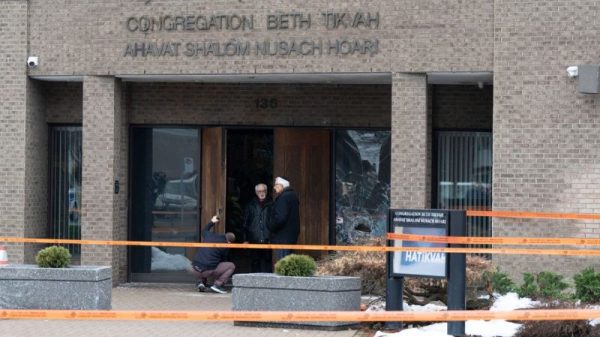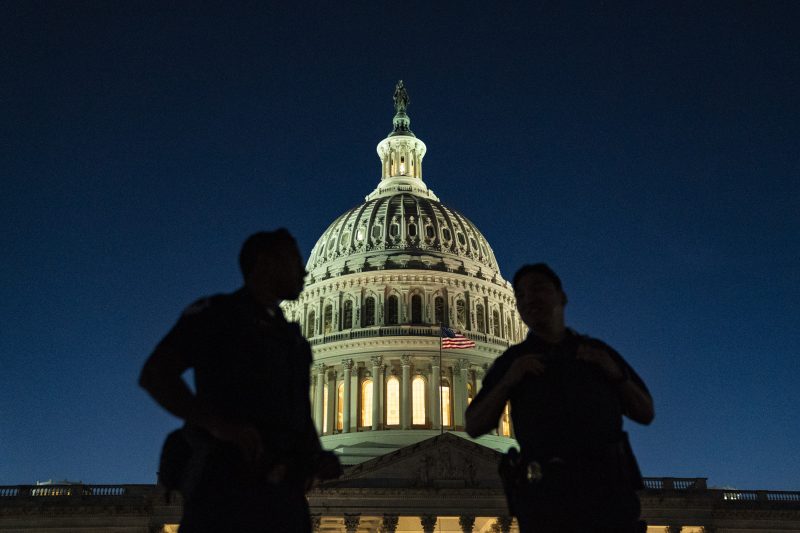Candidates running for House and Senate offices increased campaign spending on security by more than 500 percent between the 2020 election and the 2022 midterms, a new Washington Post analysis of filings with the Federal Election Commission found, a measure of the extraordinary rise in threats against elected officials in recent years and the country’s increasingly volatile political climate.
The steep increases came as changes in federal campaign finance rules made it easier to spend campaign dollars on security, a recognition of the nation’s changing threat outlook for elected officials.
Spending by House and Senate candidates rose from $1.3 million to nearly $8 million in that time, the analysis found. The Post also found that House members have spent more of the annual governmental allowance they are given to fund their offices on security, with such spending rising from about $675,000 in 2020 to $1.2 million in 2022.
But even as significant changes have been made to facilitate that increased spending, lawmakers say more has to be done to help protect themselves and their staff from a dramatic rise in daily threats.
The challenge was put in sharp relief on Jan. 6, 2021, when supporters of former president Donald Trump overran the U.S. Capitol in hopes of overturning the 2020 election results, threatening to kill officials who stood in their way. How close lawmakers came to physical violence that day became a key impetus to addressing Congress members’ vulnerability as public figures — a concern most often reserved for presidents and presidential candidates.
“We’re asking them to come in and do a difficult job already,” said Rep. Barry Loudermilk (R-Ga.), who increased security spending to protect staff in his district office by almost $2,000 when lawmakers saw an increase in their funding allocation. “They’re dealing with somewhat of a stressful environment already, and then when their physical safety is threatened, you know, you need to make sure you’re taking care of your folks.”
Lawmakers also fear that, without instituting more stringent security measures, they and their families remain vulnerable to smaller, random incidents that can turn violent. Such encounters outside of the Capitol and away from official events — or as Rep. Eric Swalwell (D-Calif.) described them, “incidents of opportunity” — leave lawmakers who don’t have security vulnerable. While high-profile lawmakers are more likely to be identified outside of Capitol Hill, others who are not household names remain cognizant that they, too, could be confronted and have taken extra steps to maintain their safety, whether changing up their route to work or keeping a low profile on flights back to their district.
Swalwell recalled one menacing incident at a Chipotle in Ohio last year. As he approached the counter to pick up food while holding his 5-year-old son’s hand, a man stopped them, cocked his head back and sneezed on them.
Disgusted, Swalwell first thought the man was simply disgruntled. But after cleaning himself and his son off and sitting in a booth, the man continued to hover over the table, whispering the California Democrat’s last name repeatedly. Later, the man again tried to sneeze on him. Swalwell pushed him away, and his wife told the man he was pathetic. The man then left the restaurant.
“We’re not far away from a member who has faced a barrage of threats being attacked at a time that they did not have a threat detail, and I hate to say that, but I know that’s coming,” said Swalwell, who has received about 250 credible threats this year.
Lawmakers and other elected officials have increasingly become targets of rhetorical threats and actual violence. Since just the 2016 presidential election, now-House Majority Leader Steve Scalise (R-La.) was shot by a left-wing extremist; far-right extremists plotted to kidnap and kill Michigan Gov. Gretchen Whitmer (D); and Paul Pelosi, the husband of Rep. Nancy Pelosi (D-Calif.), was assaulted with a hammer in their San Francisco home after a man broke in looking for the then-speaker of the House, among several other high-profile incidents.
The attack last year against Paul Pelosi in particular shook lawmakers and their families, as the realization they could become targets simply by association sunk in. If Capitol police were going to stop an attack at the home of any member of Congress, it should have been Pelosi’s, where there is around-the-clock security, lawmakers remarked.
“My wife began to express some real concerns about what she was seeing and hearing on television. … So we decided to avail ourselves of the resources available to us,” said Rep. Joseph Morelle (N.Y.), the top Democrat on the House Administration Committee, which allots funding to House offices.
“I think what all of us want to do is make sure that aside from our own personal safety, the safety of our family members should never be in jeopardy because of public service.”
Easing regulations to allow lawmakers and candidates to allot more money toward security has previously followed significant flash points of violence in modern U.S. history.
An early sign of change came shortly after Rep. Gabrielle Giffords (D-Ariz.) was shot, along with 18 other people, at a campaign event in 2011. Several months later, the FEC clarified that existing rules allowed candidates to use campaign funds for home security. The House sergeant-at-arms also amended preexisting rules to allow lawmakers to be reimbursed for expenses incurred when outfitting district offices with additional security.
The FEC again amended its rules after Scalise almost died when he and several other Republicans were shot at while practicing for the Congressional Baseball Game in 2017. After that incident, the commission changed its regulations to allow candidates to spend up to $4,000 in campaign funds on installing and upgrading home security systems. The House Administration Committee also instituted changes that allowed lawmakers to be reimbursed for hiring security at member-hosted district events or to protect a district office building.
Around the same time, the U.S. Capitol Police was seeing a spike in threats made against lawmakers. Threats, which they define as concerning statements or declared intent to commit violence, quadrupled from fewer than 900 recorded to more than 3,930 from 2016 to 2017. That number continued to tick up throughout Trump’s presidency and hit a high mark during the 2020 election, with more than 8,600 threats assessed that year.
The number of threats again increased after the Jan. 6 insurrection, peaking with almost 10,000 threats assessed in 2021.
Two months after the attack on the Capitol, the FEC responded to a letter jointly issued by the National Republican Senatorial Committee and National Republican Congressional Committee by allowing lawmakers to use campaign funds to hire bodyguards to protect them and their immediate family outside of the home. The two national campaign arms cited an “elevated threat environment” as justification for the FEC to revise its policies to help lawmakers in a modern polarized environment.
What followed has been a security spending bonanza. Campaigns spent more on security during the final two months of the 2022 election cycle than they did during the entire 2020 cycle, the data shows.
Yet as spending was ballooning, threat assessments by the Capitol Police were down compared with the two years prior, with 7,500 threats assessed. (The department noted that of that number, only 313 threat assessments were sent to federal prosecutors for review, leading to only 22 prosecutions.)
Lawmakers in March 2022 then approved a series of changes to how much House and Senate offices could spend on security. A Democratic-led Congress bumped up spending to offices’ individual budgets, called the Members’ Representational Allowance, by 21 percent, largely to help increase staff pay, but that money could also be put toward security measures. House lawmakers also raised the cap on what an individual lawmaker could spend on security to $10,000.
Expenditure data for individual House members is more complete than for senators. Senate numbers are more opaque because they don’t offer the level of detail essential for calculating changes in security-related spending.
The Senate also has benefited from the increase in funding, but it’s up each individual office whether to allot that bump for security measures. The Senate sergeant-at-arms also received an additional $2.5 million in late 2022 to create a residential security program to assist “in mitigating increased risks to the physical security of senators’ residences both in the District of Columbia and in their home states.”
Several House members declined to disclose how they have spent the new money, citing safety concerns. But they said they have broadly used funds to safeguard their homes, family cars and their district offices, and to hire security guards to protect staff in their districts.
Because of changed FEC rules, lawmakers also have more flexibility in hiring personal security for when they are in their districts. Both Republican and Democratic House lawmakers have taken advantage of the increase in funding to spend on security details.
Lawmakers have also availed themselves of resources offered by the Department of Homeland Security, which can advise them on how best to secure themselves away from the Hill. For example, Rep. Blake D. Moore (R-Utah), who increased security spending by roughly $16,700 since entering office in 2021, pays a monthly security fee to the Department of Homeland Security to continue securing the government building where his Ogden district office is located.
The Capitol Police also has stepped up its role in helping lawmakers coordinate local security for when they return to their districts, often asking members to provide an itinerary of events so they can remain aware of their whereabouts. If threats have reached a certain threshold of seriousness for a lawmaker’s safety, the department will often assign a detail to be with that lawmaker until the threats cease.
But credible threats are often hard to predict, according to lawmakers, especially if relatively unknown lawmakers suddenly find themselves in the public eye from one moment to the next.
Loudermilk, the Georgia Republican, said he was inundated with threats after the House select committee investigating the Jan. 6 attack last year showed video footage of him giving what Democrats alleged was a “reconnaissance” tour of the Capitol the day before the insurrection. Upon hearing that the committee had aired the footage, Loudermilk directed his office to contact local law enforcement to arrange protection at the airport for his arrival from Washington when he landed, as well as to get officers to protect his staff at district offices in case of a random attack.
The Capitol Police eventually said there was no evidence that Loudermilk was leading a reconnaissance tour. But by then, he had already gotten voicemails that called him “a godd— traitor who better beef up his security” and included repeated graphic intentions of killing him, his family and friends. One caller directly threatened a female staffer who answers calls for the office, saying she should be “dragged onto the street and beaten until you’re a bloody mess.”
The unpredictability of when threats come makes it tricky for the Capitol Police and local law enforcement to maintain a constant security presence around lawmakers, which many members recognize is an impossible task. Rep. Angie Craig (D-Minn.) was assaulted in her apartment building elevator earlier this year by an assailant who did not target her specifically. Capitol Police officers often drive by lawmakers’ Washington homes, but they do not offer around-the-clock protection, according to a senior congressional aide with knowledge of the practice who spoke on the condition of anonymity to detail sensitive security information.
Rep. Barbara Lee (D-Calif.), who is now running for Senate, has become all too familiar with deadly threats throughout her 24 years in the House. In an interview, she recalled hearing gunshots being played over the phone and opponents holding banners that read “Barbara Lee hates America” after she became the sole lawmaker to vote against the authorization for use of military force in the week after the Sept. 11, 2001, attacks.
The threats continue and are so consistent on social media and calls to her office that staff sends the Capitol Police a recap of the most violent ones each week. She has increased spending on security by $10,000 since fiscal year 2020, according to Members’ Representational Allowance data. Throughout the course of her career, the Capitol Police has often assigned her security to escort her until threats subside.
“But you don’t let it overwhelm you because, you know, it could be emotionally stifling. It could immobilize you for doing your job,” Lee said.
While the Capitol Police does not disclose which lawmakers receive the most threats, Pelosi has often faced a barrage of threats given her high profile. She increased her own security spending by roughly $10,000 in the year after Jan. 6, according to the MRA data, even while having permanent security with her at all times because of her leadership position. (Pelosi continues to have security with her, though it’s a smaller group since she left the House Democratic leadership).
Rep. Sheila Jackson Lee (D-Tex.) has increased her spending on security more than any other House lawmaker during that same time frame, increasing it by $181,200, followed by Ayanna Pressley (D-Mass.), who increased spending by over $72,500, and Rep. Al Green (D-Tex.), who increased his spending by $51,000.
Of the 30 House lawmakers who spent the most on security in fiscal year 2022, 22 are Democrats and eight are Republicans; 11 are people of color; 21 are men and nine are women.
If threats reach a certain threshold, the Capitol Police assigns personal details for lawmakers’ protection around-the-clock until they subside. It is not uncommon to see Reps. Ilhan Omar (D-Minn.) or Alexandria Ocasio-Cortez (D-N.Y.) with a security presence around them, an indicator that credible death threats exist. Sen. Marco Rubio (R-Fla.) had security assigned to him for a substantial amount of time in 2017 when Venezuela reportedly issued a death order against him.
Rep. Bennie G. Thompson (D-Miss.) was one of those members assigned a detail because of the high-profile work he was doing as chairman of the select committee investigating Jan. 6. During that time, he said, the Capitol Police surveyed committee members’ district offices and homes to make recommendations about how to best secure each location. Since fiscal year 2020, Thompson has increased his security spending by $20,000.
The threats against committee members reached such a high threshold last year that the Capitol Police “worked out a contract with local law enforcement to provide 24-hour protection at our home when members were in the district,” Thompson said. The department has also opened remote offices across the country since Jan. 6 to closely monitor regional threats, with locations in Florida, California, Massachusetts, Wisconsin and Texas.
Capitol Police Chief Thomas Manger has routinely testified to Congress that the force is still stretched too thin given staffing shortages and the ongoing number of threats. In May he told lawmakers that roughly 400 officers had quit since Jan. 6.
In its latest effort to protect members of Congress, the department launched a new recruiting campaign last month. For the first time, it has opened the application process to external candidates in search for agents and investigators. Before the change, the department would exclusively hire agents and investigators internally from their protection and investigations divisions.
A member of the House Administration Committee, Loudermilk has applauded Capitol Police’s efforts to continue aiding lawmakers. But as Republicans look to cut spending, he has echoed concerns about just throwing more money at the department. Instead, he is open to a bipartisan conversations about how to relax regulations to help lawmakers feel protected back home, advocating an approach that allows for “security that is flexible, that is local, and is scaled appropriately to what the member needs.”
“We need to work as a Congress. We focus a lot on Capitol Hill security … but that still leaves 435 [House] members and their staff with some vulnerabilities back home. And you can’t do one-size-fits-all because everyone is in a different district,” he said.


































